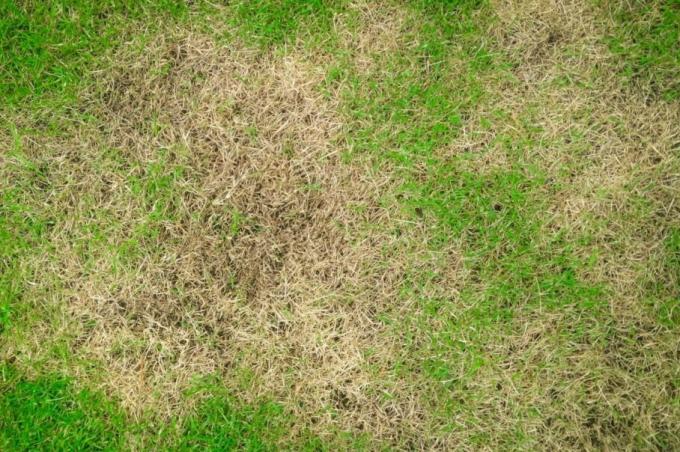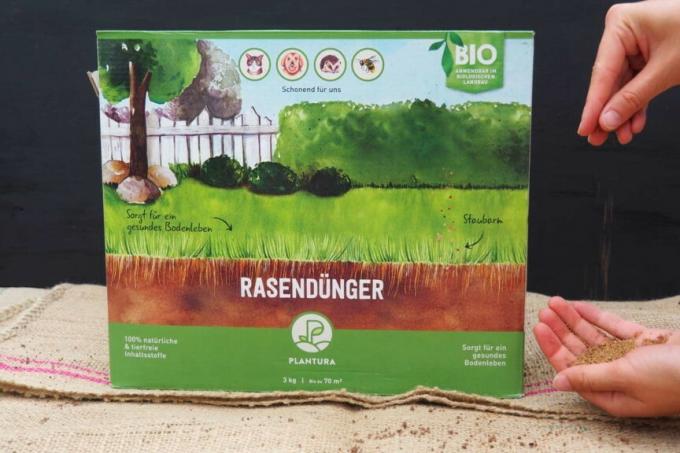An over-fertilized lawn has many faces. We explain how to recognize the symptoms of over-fertilization and what can be done about it.

If you take a very close look at your own or the neighboring lawns, you will quickly find out fixed: There is a bare spot, discoloration or another flat spot somewhere in almost every lawn blemish. Sometimes the reason for this is simply that the Choosing the right lawn seed mix didn't succeed. Another reason for such lawn damage can be the excessive use of mineral lawn fertilizers. In this article we explain how you can recognize over-fertilization and what you can do to prevent or acutely counteract it. If you also want general information on the subject fertilize lawn are looking for, you will find what you are looking for in our overview article.
contents
- How do I recognize over-fertilization in the lawn?
- How do the burn spots in the lawn develop?
- What can you do to prevent over-fertilization in lawns?
- Fertilize your lawn correctly: tips for correct application
If a purely mineral fertilizer is used when fertilizing the lawn, over-fertilization can easily occur. Slight and heavy over-fertilization can be recognized by different characteristics, which we would like to briefly present to you. Then we give tips on how to save your battered lawn.
How do I recognize over-fertilization in the lawn?
What over-fertilization looks like depends on how dramatic the over-fertilization was. In milder cases, nutrient-typical excess symptoms appear on the lawn plants. We have summarized the most important ones in a table here.
| nutrient | Excess Syndrome |
|---|---|
| nitrogen (N) | - Excessive, masty growth; brittle, curled or thickly swollen leaves - Susceptibility to frost damage - Dark green coloring - Susceptibility to fungal diseases - Death of the root - Causes calcium and magnesium deficiency: growth retardation, leaf tip death, reduced root growth, yellowing |
| phosphate (P) | - No/hardly any symptoms on the plant - "Fixation" in the soil, with very strong over-fertilization also leaching into the groundwater and contamination of natural waters |
| Potassium (K) | - Causes calcium deficiency: growth inhibition, death of the leaf tips |
| Magnesium (M) | - Causes calcium deficiency: growth inhibition, death of the leaf tips |
Slight overfeeding is not too dramatic and does not need to be treated. In the future, however, you should be careful not to distribute too much of the excess nutrient. Or you can rely on a primarily organic lawn fertilizer like ours Plantura organic lawn fertilizer. This makes over-fertilization almost impossible due to the slow conversion of nutrients.
In the case of severe over-fertilization, the lawn grasses first turn yellow, then brown and finally die off over the entire area. The layman may then speak of "burns", but in fact it is the high concentration of fertilizer salts in the soil that causes problems for the roots of the lawn.
How do the burn spots in the lawn develop?
The "burns" are caused by the so-called exosmosis. In order to better understand this term, one should deal a little with the nutrient uptake of plants. Plants actively absorb many of the required nutrient ions into the root hair cells through special channels. This increases the concentration of ions in these cells. As water moves from low ionic concentrations to higher ionic concentrations, cells filled with nutrient ions attract and absorb water. In this way, the water balances the concentrations in root hair cells and soil. It is said that the water follows the “osmotic gradient”. So plants actively create a kind of suction to absorb water.
This effect is reversed in the case of severe over-fertilization, hence the term “exosmosis”: if on once there are a great many nutrient ions outside the root, the concentration of particles is there higher. The osmotic gradient then runs the other way around and the plant roots cannot absorb so many ions that there is a higher concentration in their roots. As a result, the water migrates out of the plant and it can therefore no longer maintain its vital functions. Incidentally, road salt also causes damage to plants in this way.

tip: Also spilled petrol or petrol mixture, chain oil of a chainsaw, pesticides or cleaning agents that have accidentally gotten onto the lawn, supply in sufficient quantities bald spots. For this reason, devices should only be refueled on paved surfaces and cleaning agents therefore do not belong in the garden. In our Plantura shop you will find environmentally friendly alternatives to harmful pesticides.
What can you do to prevent over-fertilization in lawns?
It's already happened: when filling the fertilizer spreader, the sack with the mineral lawn fertilizer tipped over and the contents were spread over half a square meter of lawn. Now you should proceed quickly and thoroughly:
- With gloved hands, remove as much fertilizer from the lawn as possible
- Use a rake to rake as many grains of fertilizer out of the turf as possible
- Water the affected area thoroughly and for a long time - this will dilute the increased nutrient concentration
If you have applied too much fertilizer to your entire lawn, thorough watering will also help. Incidentally, this is actually a basic rule when fertilizing lawns: It is best to only spread fertilizer if rain is forecast for the next day. If this is not the case, the fertilizer must be brought into the soil by watering and diluted.
However, if over-fertilization has happened or perhaps a dog has peed a hole in the lawn with its urine unnoticed, only this can help lawn repair at this point. The fast-germinating seeds of Lolium perenne and Festuca rubra like in ours Plantura lawn repair now protect the bald spot from the emergence of unwanted weeds.
Of course, it is better to take precautions directly, which we would like to recommend to you at this point. Here are some tips to avoid over-fertilizing:
- It is best to use organic or mostly organic fertilizers. These are implemented slowly, even if they are distributed too generously, there can be no severe over-fertilization.
- Our plants Organic Lawn Fertilizer and Organic autumn lawn fertilizer protect against over-fertilization.
- Always (if at all) use mineral fertilizers strictly according to the dosage recommendations.
- Always leave fertilizer sacks on paved surfaces and fill buckets or fertilizer spreaders there.
- Always check the function and adjustment of the fertilizer spreader before use.
- Water after fertilizing or fertilize when rain is forecast.
Fertilize your lawn correctly: tips for correct application
If you use our Plantura Organic Lawn Fertilizer use, do the following:
- Fertilize 2 or 3 times a year
- Mow your lawn fairly short
- Spread 40 to 60 g/m² of our Plantura organic lawn fertilizer by hand or use our recommended settings for fertilizer spreaders as a guide.
- If you don't have a scale at hand: A water glass with a volume of 0.2 L corresponds to 130 g of our fertilizer. Accordingly, a filled 1 L bucket contains 650 g of our fertilizer
- Our predominantly organic fertilizers do not cause over-fertilization, but sprinkling results in the nutrients taking effect more quickly.

Tip: Is your lawn always yellow and dried out in summer? Of course, this does not have to be related to over-fertilization. If your soil is light and sandy and your lawn is in full sun, you may want to think about planting a special dry lawn. Our certified is perfect for this Plantura dry grassland, composed of drought-tolerant grasses. We are also happy to give you tips on how to use a potassium-rich autumn lawn fertilizer like ours Plantura Organic Autumn Lawn Fertilizer can minimize not only frost damage, but also drought damage.
How to his Lawn fertilized in the right amount and thus avoid over-fertilization, you can find out here in our overview article.
And in another special article we have general information for you lawn fertilizers collected.
